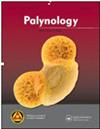Ordovician chitinozoans of the Miaopo Formation at Zhenjin, Upper Yangtze Platform, South China
IF 1.3
4区 地球科学
Q3 PALEONTOLOGY
引用次数: 0
Abstract
ABSTRACTChitinozoan investigations on the late Middle to early Late Ordovician in South China are limited. Documented chitinozoan occurrences are mainly from the Miaopo Formation on the Upper Yangtze Platform. The present study reports new data from the Miaopo Formation at the Zhenjin section in the Yichang area. In total, 13 genera and 33 species are recognised, and three new species are described: Spinachitina? coronifera sp. nov., Lagenochitina yichangella sp. nov. and Pellichitina confragosa sp. nov. The Baltoscandian index species, Laufeldochitina striata, is documented in the lowermost part of the formation. This is the first report of this species in South China. The L. striata Biozone is suggested for the basal part of the formation due to the presence of the eponymous species. The index species of the Laufeldochitina stentor Biozone, the Armoricochitina granulifera and Cyathochitina megacalix subzones adopted in the Jieling section are also observed in the Zhenjin section. However, according to the new data obtained at Zhenjin, the first appearance datum of C. megacalix and A. granulifera coincides with that of L. striata. Therefore, the C. megacalix Subzone is kept but moved to the L. striata Biozone. A. granulifera has stable occurrences in almost the entire Miaopo Formation, corresponding to the Nemagraptus gracilis graptolite biozone. It is slightly older than Baltic records but could be useful for recognising this time interval in South China.Keywords: biostratigraphyChinaChitinozoaMiddle-Late Ordovicianlatest Darriwilian to SandbiantaxonomyDisclaimerAs a service to authors and researchers we are providing this version of an accepted manuscript (AM). Copyediting, typesetting, and review of the resulting proofs will be undertaken on this manuscript before final publication of the Version of Record (VoR). During production and pre-press, errors may be discovered which could affect the content, and all legal disclaimers that apply to the journal relate to these versions also.上扬子镇金庙坡组奥陶系几丁质动物
摘要华南地区晚奥陶世晚期至晚奥陶世早期几丁虫研究有限。有文献记载的几丁质动物主要产于上扬子地台庙坡组。本文报道了宜昌地区镇金剖面庙坡组的新资料。共鉴定出13属33种,并描述了3个新种:Spinachitina?Baltoscandian指数物种Laufeldochitina striata位于该地层的最下部。本种在华南地区首次报道。由于同名物种的存在,我们认为该地层的基部为L. striata生物带。在镇金剖面上还观察到介岭剖面采用的Laufeldochitina stentor生物带、Armoricochitina granulifera亚带和Cyathochitina megacalix亚带的指标种。然而,根据在镇津获得的新资料,巨萼草和细粒草的首次出现时间与条纹草的首次出现时间一致。因此,巨萼草亚区被保留,但被转移到条纹草生物带。A. granulifera几乎在整个庙坡组都有稳定的产状,对应于Nemagraptus gracilis笔石生物带。它比波罗的海的记录稍早,但可能有助于识别中国南部的这个时间间隔。关键词:生物地层学中国-中晚奥陶世-石蜡目动物最新达里威廉-桑比亚分类学免责声明作为对作者和研究人员的服务,我们提供了这篇被接受的手稿(AM)。在最终出版版本记录(VoR)之前,将对该手稿进行编辑、排版和审查。在制作和印前,可能会发现可能影响内容的错误,所有适用于期刊的法律免责声明也与这些版本有关。
本文章由计算机程序翻译,如有差异,请以英文原文为准。
求助全文
约1分钟内获得全文
求助全文
来源期刊

Palynology
地学-古生物学
CiteScore
3.40
自引率
26.70%
发文量
48
审稿时长
>12 weeks
期刊介绍:
Palynology is an international journal, and covers all aspects of the science. We accept papers on both pre-Quaternary and Quaternary palynology and palaeobotany. Contributions on novel uses of palynology, review articles, book reviews, taxonomic studies and papers on methodology are all actively encouraged.
 求助内容:
求助内容: 应助结果提醒方式:
应助结果提醒方式:


